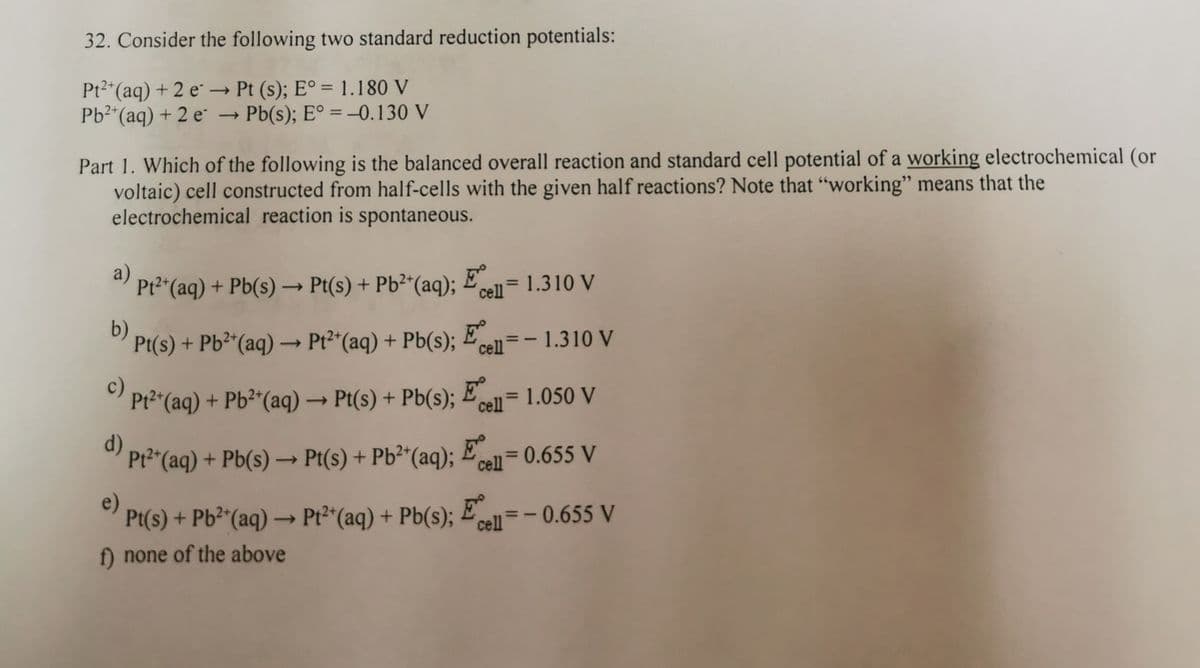32. Consider the following two standard reduction potentials: Pt2"(aq) + 2 e → Pt (s); E° = 1.180 V Pb"(aq) + 2 e → Pb(s); E° = –0.130 V Part 1. Which of the following is the balanced overall reaction and standard cell potential of a working electrochemical (or voltaic) cell constructed from half-cells with the given half reactions? Note that "working" means that the electrochemical reaction is spontaneous. a) Pt2"(aq) + Pb(s) → Pt(s) + Pb²"(aq); = 1.310 V cell Pt(s) + Pb* (aq) – Pt"(aq) + Pb(s); cell - 1.310 V Pt* (aq) + Pb3 (aq) → Pt(s) + Pb(s); cell = 1.050 V d) p Pr*"(aq) + Pb(s) → Pt(s) + Pb²"(aq); cell 0.655 V e) Pt(s) + Pb²"(aq) → Pt2"(aq) + Pb(s); £cel 0.655 V f) none of the above
32. Consider the following two standard reduction potentials: Pt2"(aq) + 2 e → Pt (s); E° = 1.180 V Pb"(aq) + 2 e → Pb(s); E° = –0.130 V Part 1. Which of the following is the balanced overall reaction and standard cell potential of a working electrochemical (or voltaic) cell constructed from half-cells with the given half reactions? Note that "working" means that the electrochemical reaction is spontaneous. a) Pt2"(aq) + Pb(s) → Pt(s) + Pb²"(aq); = 1.310 V cell Pt(s) + Pb* (aq) – Pt"(aq) + Pb(s); cell - 1.310 V Pt* (aq) + Pb3 (aq) → Pt(s) + Pb(s); cell = 1.050 V d) p Pr*"(aq) + Pb(s) → Pt(s) + Pb²"(aq); cell 0.655 V e) Pt(s) + Pb²"(aq) → Pt2"(aq) + Pb(s); £cel 0.655 V f) none of the above
Chemistry: An Atoms First Approach
2nd Edition
ISBN:9781305079243
Author:Steven S. Zumdahl, Susan A. Zumdahl
Publisher:Steven S. Zumdahl, Susan A. Zumdahl
Chapter17: Electrochemistry
Section: Chapter Questions
Problem 135CWP: Consider a galvanic cell based on the following half-reactions: a. What is the expected cell...
Related questions
Question

Transcribed Image Text:32. Consider the following two standard reduction potentials:
Pt2"(aq) + 2 e → Pt (s); E° = 1.180 V
Pb2"(aq) + 2 e
→ Pb(s); E° = -0.130 V
%3D
Part 1. Which of the following is the balanced overall reaction and standard cell potential of a working electrochemical (or
voltaic) cell constructed from half-cells with the given half reactions? Note that "working" means that the
electrochemical reaction is spontaneous.
a)
" Pt2 (aq) + Pb(s) → Pt(s) + Pb²*(aq); Ecelnl= 1.310 V
+ Pb(s) → Pt(s) + Pb²*(aq); £
%3D
b)
Pt(s) + Pb²*(aq) → Pt2*(aq) + Pb(s);
E
cell -1.310 V
c)
Pt2"(aq) + Pb²*(aq)→ Pt(s) + Pb(s);
= 1.050 V
%3D
->
cell
d)
" Pr2"(aq) Een=0.655 V
+ Pb(s) –
Pt(s) + Pb²*(aq);
%3D
cell
e)
Pt(s) + Pb²"(aq) → Pt2*(aq) + Pb(s); £
cell=-0.655 V
f) none of the above

Transcribed Image Text:Part 2. In the above working electrochemical (or voltaic) cell in Part 1, what species is reduced in cathode?
a) Pt (s)
b) Pt2* (aq)
c) Pb (s)
d) Pb²* (aq)
e) None of the above
Part 3. From Part 1, one can conclude that
a) Pt (s) is a stronger reducing agent than Pb (s).
b) Pb (s) is a stronger reducing agent than Pt (s).
c) Pt (s) is a stronger oxidizing agent than Pb (s).
d) Pb (s) is a stronger oxidizing agent than Pt (s).
e) none of the above
Expert Solution
This question has been solved!
Explore an expertly crafted, step-by-step solution for a thorough understanding of key concepts.
Step by step
Solved in 2 steps

Knowledge Booster
Learn more about
Need a deep-dive on the concept behind this application? Look no further. Learn more about this topic, chemistry and related others by exploring similar questions and additional content below.Recommended textbooks for you

Chemistry: An Atoms First Approach
Chemistry
ISBN:
9781305079243
Author:
Steven S. Zumdahl, Susan A. Zumdahl
Publisher:
Cengage Learning

Chemistry
Chemistry
ISBN:
9781305957404
Author:
Steven S. Zumdahl, Susan A. Zumdahl, Donald J. DeCoste
Publisher:
Cengage Learning


Chemistry: An Atoms First Approach
Chemistry
ISBN:
9781305079243
Author:
Steven S. Zumdahl, Susan A. Zumdahl
Publisher:
Cengage Learning

Chemistry
Chemistry
ISBN:
9781305957404
Author:
Steven S. Zumdahl, Susan A. Zumdahl, Donald J. DeCoste
Publisher:
Cengage Learning



Chemistry: Principles and Practice
Chemistry
ISBN:
9780534420123
Author:
Daniel L. Reger, Scott R. Goode, David W. Ball, Edward Mercer
Publisher:
Cengage Learning

Chemistry & Chemical Reactivity
Chemistry
ISBN:
9781337399074
Author:
John C. Kotz, Paul M. Treichel, John Townsend, David Treichel
Publisher:
Cengage Learning